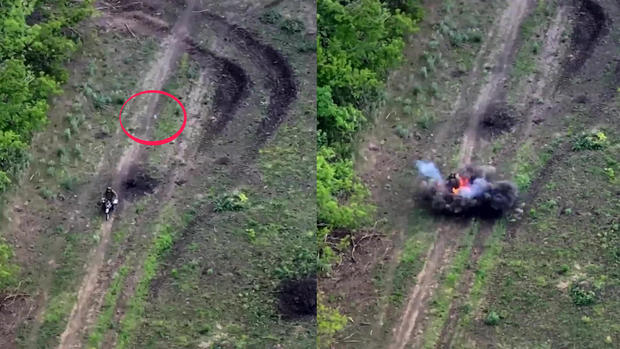How Russia, Ukraine deploy new technologies, tactics on the battlefield
There's a new look of the Russian army in Ukraine: Soldiers on motorcycles who race across no-man's land, counting on speed to evade Ukrainian fire … but not always able to outrun the swarms of drones which hover over the battlefield and can pick off fighters one-by-one.

George Barros, of the Institute for the Study of War, says it's one of the new tactics Russia has used to seize 430 square miles of territory over the past nine months.
"At the moment the Russians have the upper hand," Barros said. "The Russians are able to choose where, when, the tempo of battle, and what intensity that they want to conduct offensive operations anywhere along this entire 600-mile front line. … It puts them within striking distance of some very important ground lines of communication [and] supply corridors that connect some of the really important large cities that constitute the backbone of Ukraine's defense of eastern Ukraine."
But the price Russia is paying to make these advances is very high; according to Barros, the Russians are losing between 25,000 to 30,000 troops per month. By some estimates Russia has suffered a staggering half-million killed or wounded since the invasion began in February 2022.
Yet, Putin has been able to replace those losses, and pursue his merciless, long-war strategy – endless assaults to grind down Ukraine's ability to resist, coupled with threats of nuclear war against nations supporting Ukraine.
- Inside the NATO talks over long-term aid for Ukraine
- Putin says talk of NATO troops being sent to Ukraine "raises the real threat of a nuclear conflict"
Barros said, "Putin understands what's going to make or break this war is whether or not the allied states that support Ukraine decide to lean into it or not."
The United States leaned way back when politics caused a five-month suspension in arms shipments to Ukraine.
- Senate Republicans block Ukraine, Israel aid bill
- White House criticizes House Republicans for inaction on Ukraine aid
The delay occurred just as the Russian air force was unleashing a devastating new weapon. Barros said, "The Russians discovered that they can put these cheap glide kits onto the glide bombs, and convert their large Soviet-era stockpiles of dumb gravity bombs into a precision weapon."
The bombs sprout wings in flight and, guided by a GPS signal, glide toward targets 30 to 40 miles away, while Russian pilots remain out of range of Ukraine's air defenses. "They can use their air power and 500-kilogram bombs to pummel and destroy Ukrainian trenches, bunkers, strong points and fortifications," Barros said.
Thousands of bombs and millions of artillery shells have turned the battlefield into a moonscape of craters. One became a death trap for a Russian tank when a tiny Ukrainian drone attacked it.
- Switchblade drone: How the "kamikaze" anti-tank weapon works ("Sunday Morning")
- How HIMARS launchers are shifting momentum in Ukraine's fight against Russia ("Sunday Morning")
- With new weapons, Ukraine goes on the offensive ("Sunday Morning")
Russia has tried protecting its tanks with extra layers of armor, but for every measure there is a counter-measure – and American weapons are once again flowing to Ukraine.
- U.S. to announce $2.3 billion in military assistance for Ukraine
- Biden warns about "price of unchecked tyranny" as he vows to continue to help Ukraine
Barros said, "As long as the Russians actually fail in convincing the international coalition from continuing to support Ukraine, the Russians have no chance of winning in Ukraine."
As with all wars, it comes down to will. "Political will is the decisive factor for this war," said Barros. "It's not what happens on the battleground; territory can be lost, ceded, and recaptured again. But if we make the decision to abandon the Ukrainians, they will lose. Honestly, the center of gravity for this war, it's not the field in Ukraine, but what happens here in Washington, just like it was in World War II, just like it is today."
For more info:
- George Barros, Institute for the Study of War
Story produced by Mary Walsh. Editor: Joseph Frandino.
See also:
- Ukrainians' fight for survival entering its third year ("Sunday Morning")
- Gen. Mark Milley on seeing through the fog of war in Ukraine ("Sunday Morning")
- How to blast through a Russian minefield ("Sunday Morning")
- The fight for Ukraine: 2023 witnesses a war of attrition ("Sunday Morning")
- In:
- Ukraine
- Russia

David Martin has been CBS News' national security correspondent, covering the Pentagon and the State Department, since 1993.
TwitterDisclaimer: The copyright of this article belongs to the original author. Reposting this article is solely for the purpose of information dissemination and does not constitute any investment advice. If there is any infringement, please contact us immediately. We will make corrections or deletions as necessary. Thank you.







